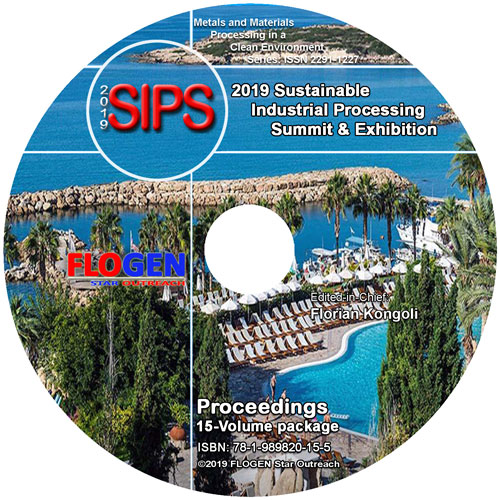2019-Sustainable Industrial Processing Summit
SIPS2019 Volume 8: Usui Intl. Symp. / Advanced Sustainable Iron and Steel Making
| Editors: | F. Kongoli, P. Assis, M.C. Gomez-Marroquin, S. Kitayama, H. Konishi, A. Murao, S. Nomura, H. Ono, H. Saxen, K. Seto, J.I. Tani |
| Publisher: | Flogen Star OUTREACH |
| Publication date: | 20 December 2019 |
| Pages: | 250 pages |
| ISBN: | 978-1-989820-07-0 |
| ISSN: | 2291-1227 (Metals and Materials Processing in a Clean Environment Series) |

CD shopping page
Reduction of Material and Utilities Consumption by optimization of the usage at I- Blast Furnace
Padma pal1; Basant Kumar Singh1; Bhaskar Ramdasu1; Dhiren Patnaik2; Vishwakarma Raj Kumar3; G.S.R. Murthy .3; Singh Anil Kumar4;1TATA STEEL, Jamshedpur, India; 2TATA STEEL LTD., JAMSHEDPUR, India; 3TATA STEEL LTD., Jamshedpur, India; 4TATA STEEL LTD, Jamshedpur, India;
Type of Paper: Keynote
Id Paper: 221
Topic: 2
Abstract:
The rapid increase in world steel output during the last three decades has been accompanied by a growing geographical distribution of production, especially among developing countries. There have been tendencies towards both larger and more efficient units for achieving high production and less environmental impact. Currently, about 40% of steel is manufactured from recycled scrap, which uses only 15-20% of the energy needed to make steel from virgin ore. The cut throat competition from the electric furnaces and environmental norms is getting more stringent. The very sustenance of Blast Furnace is chiefly dependent on the level of optimized usage of available raw material. Apart from the regular raw materials, like coke, coal, iron bearing materials and fluxes, the blast furnaces also consume many utilities such as nitrogen, steam, water and consumables for safe and efficient operation. This paper elaborates the actions taken to reduce the raw materials, utilities and consumables, thereby saving over USD 30 M.
Keywords:
Blast; Carbon; Coke; Furnace; Iron; Nitrogen; Steel;References:
1. Elsayed A. MOUSA, Alexander BABICH and Dieter SENK: ISIJ International, Vol. 51 (2011)2. Maarten Geerdes Hisko Toxopeus Cor van der Vliet; Modern Blast Furnace Ironmaking-an introduction; second edition 2009